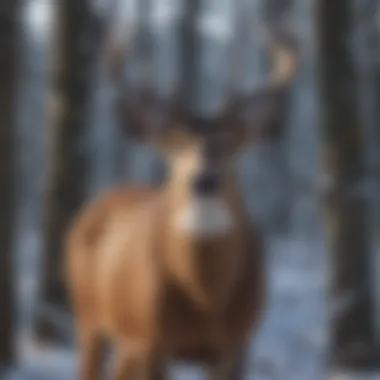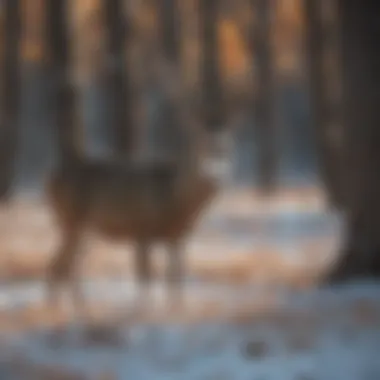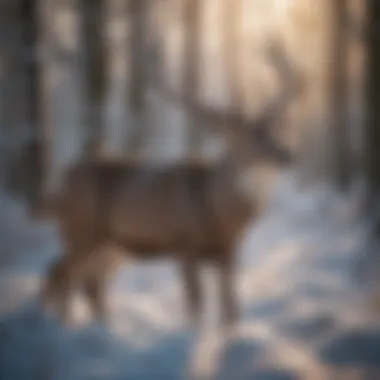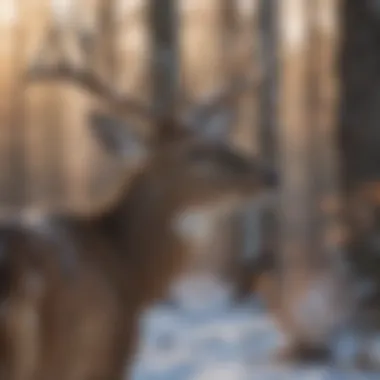Nourishing Whitetails: Winter Feeding Practices


Intro
Winter presents unique challenges for whitetail deer. As natural food sources diminish due to snow cover and freezing temperatures, understanding how to properly feed these animals becomes essential. This guide aims to shed light on the best practices for winter feeding, nutritional requirements, and ethical considerations for deer management, enhancing the health and sustainability of these iconic creatures.
Animal Species Profile
Foreword to the animal species
Whitetail deer, or Odocoileus virginianus, are one of the most widely distributed large mammals in North America. Their adaptability allows them to thrive in a variety of habitats, from woodlands to suburban areas. This species is a crucial part of the ecosystem, contributing to both ecological balance and cultural significance.
Physical characteristics and appearance
Whitetails are easily recognized by their slender body and white tail, which they raise as a warning signal. Adult males, known as bucks, typically weigh between 130 to 300 pounds, while females, or does, range from 90 to 200 pounds. Bucks possess antlers that shed annually, usually growing larger each year, symbolizing their maturity.
Natural habitat and distribution
Whitetail deer inhabit diverse environments, from forests to grasslands and urban areas. Their range extends across the United States, southern Canada, and parts of Mexico. This adaptability plays a significant role in their survival during harsh winters, although a decline in available food can pose serious threats to their health.
Behavior and social interactions
Whitetails are generally social animals. They form small groups, primarily consisting of females and their offspring. Males often become solitary or join in small bachelor groups after the breeding season. Communication occurs through vocalizations, body language, and scent markings, indicating a sophisticated social structure.
Nutrition Needs in Winter
Nutritional requirements
In winter, the energy requirements of whitetails increase due to cold temperatures and limited food availability. Their diet must include adequate levels of protein, carbohydrates, and fats to maintain body condition. Special attention should be paid to the nutritional quality of forage, as this impacts survival rates and reproductive success.
Suitable feed types
High-quality hay, specially formulated deer feeds, and grains can supplement the natural diet of whitetails in winter. Legumes, such as alfalfa, are particularly beneficial, as they provide protein and essential nutrients. It's important to avoid feeding deer corn exclusively, as it lacks necessary vitamins and can cause health problems.
Practical Methods for Winter Feeding
Feeding whitetails requires careful planning. Locations should be chosen for their accessibility and minimal disturbance to natural behaviors. Feeding should occur in small amounts to prevent waste and encourage consumption of higher quality feed. This can also reduce competition among deer, making sure that all can access food.
Potential Challenges
When feeding deer during winter, several challenges arise. One major concern is the risk of disease transmission, particularly through the concentration of animals at feeding sites. Additionally, inconsistent feeding schedules may disrupt natural foraging behaviors, which can be harmful in the long run.
Ethical Considerations
Feeding wildlife should always be approached with caution. It's important to consider the legal regulations that govern deer feeding in different regions. Moreover, reliance on human-provided food can lead whitetails to become dependent, potentially altering their natural behaviors and habitat use.
Finale
Responsible winter feeding practices for whitetail deer can contribute significantly to their health and sustainability. By understanding their nutritional needs and employing best practices, we can support these animals through challenging winter months. This knowledge empowers individuals and organizations committed to wildlife management and conservation efforts.
Foreword to Winter Feeding for Deer
Understanding the winter feeding of deer is a critical aspect of wildlife management, particularly when it comes to the health and sustainability of whitetail populations. During the colder months, natural food sources become scarce. This scarcity can lead to malnutrition, weakened immune systems, and increased mortality rates among deer. Therefore, establishing effective winter feeding practices becomes essential in supporting deer populations through harsh conditions.
A primary benefit of winter nutrition is its role in maintaining the overall health of deer. Adequate nutrition enhances their ability to withstand cold temperatures, which is crucial for their survival. Promoting good health also translates to better reproduction rates in the spring, as does require additional energy for gestation and fawn-rearing. Additionally, healthier deer are less susceptible to diseases, thus maintaining a balanced ecosystem.
From a management perspective, understanding winter feeding practices allows wildlife enthusiasts and pet owners to support deer effectively. Organizations and public agencies tasked with wildlife conservation can also benefit from this knowledge. By implementing informed feeding strategies, stakeholders can play a key role in ensuring that whitetails thrive, contributing to biodiversity and ecological balance.
In summary, comprehending the importance of winter nutrition and the corresponding practices is not merely an academic exercise—it is a responsibility shared by all those who care for and seek to protect wildlife.


Importance of Winter Nutrition
Winter nutrition is indispensable due to the physiological changes deer undergo during this period. During winter, the energy requirements of whitetails increase as they strive to maintain body temperature in the face of chilling temperatures. The lack of natural forage necessitates additional feeding, which underscores the importance of understanding what constitutes an appropriate diet in these months.
By offering an effective winter feeding strategy, landowners can ensure that deer have access to the necessary nutrients that may be absent or deficient in their natural habitat. This nutrition is vital for immunity, continued growth, and general well-being. Without proper nutrition, deer may suffer from nutritional deficiencies, resulting in stunted growth, weakened reproductive performance, and higher susceptibility to diseases.
Impact of Seasonal Changes on Deer Diet
Seasonal changes significantly influence the dietary habits of deer. During the fall, whitetails are able to consume a wide variety of forage. However, as winter sets in, many of these food sources become unavailable. Frost, deep snow, and frozen ground reduce the accessibility of grasses, legumes, and other plants that deer typically rely upon.
Furthermore, the quality of available food sources can diminish over time. Many deer switch to browsing woody plants, which have lower nutritional value compared to their fall diets. The reliance on these less nutritious sources can lead to malnutrition when deer do not receive supplementary feeding.
Understanding these impacts allows for better-informed decisions regarding supplemental feeding. Properly timed and strategically placed feeder stations can help mitigate the effects of seasonal dietary changes, ensuring that deer receive balanced nutrition throughout the winter months.
"Seasonal changes compel deer to adapt their diets, emphasizing the importance of winter supplemental nutrition to sustain their health and population."
Understanding Deer Nutritional Needs
Understanding the nutritional needs of deer is fundamental for ensuring their health, especially during the winter months. As temperatures drop and food becomes less accessible, proper nutrition is essential for maintaining energy levels, reproductive health, and overall vitality. In this section, we will explore the key aspects related to the macronutrients and micronutrients that are vital for deer. Addressing these elements can help in assessing the effectiveness of winter feeding practices and developing strategies that promote the well-being of these animals.
Macronutrients Essential for Deer
Deer require three primary macronutrients: carbohydrates, proteins, and fats. Each plays a crucial role in the overall functioning of the deer's body.
- Carbohydrates provide the necessary energy for daily activities. In colder months, deer tend to need significant energy to maintain body heat and sustain regular movement. Winter forages like woody browse may not offer high carbohydrate levels, making supplementary feeding particularly important.
- Proteins are vital for growth, maintenance, and development of muscle and antler tissue. Young deer need higher protein levels to support their growth spurts, while does require extra protein to support their fawns. High-quality feed can help fulfill these protein requirements during winter.
- Fats serve as an energy reserve for deer. While not consumed in large quantities, fat is essential for efficient energy storage, which deer rely on during the deer’s most energy-demanding months.
Micronutrients and Their Role in Health
While macronutrients are crucial, micronutrients cannot be overlooked. These include vitamins and minerals that support various physiological functions in deer.
- Vitamins such as A, D, and E are important for vision, bone health, and reproductive success. A deficiency in these vitamins can lead to health challenges, affecting the deer’s ability to thrive in winter.
- Minerals such as calcium, phosphorus, and salt are critical for bone growth and muscle health. Balancing these minerals in feed can help improve the health of deer, particularly in regions where natural food sources may lack sufficient mineral content.
It is clear that both macronutrients and micronutrients contribute significantly to the well-being of deer during winter. Knowing their specific requirements can facilitate more effective feeding practices. By understanding these nutritional needs, deer caretakers, wildlife enthusiasts, and animal lovers can make informed decisions that support the health and longevity of these animals during the harsh winter months.
Natural Food Sources in Winter
Understanding natural food sources during winter is crucial for the health of whitetails. As temperatures drop, deer face challenges finding adequate nutrition. Natural forage not only supports their physical needs but also impacts their behavior and reproductive success. By knowing what deer eat during cold months, wildlife enthusiasts can contribute to their welfare while respecting environmental limits.
Available Forages in Cold Months
During winter, deer rely on specific types of forages that can withstand low temperatures. These include:
- Dry grasses: Though less nutritious, they provide necessary roughage.
- Buds and twigs: Many trees shed leaves, but their buds remain viable. Species like aspen and birch are particularly favored.
- Herbaceous plants: Some perennial plants continue to offer greenery in early winter.
These food sources maintain energy levels in deer. It is important to note that deer have a selective grazing behavior. They often prefer the new growth that may emerge from snowy terrain. The availability of these forages can vary based on the region and the severity of the winter. Managers should observe deer behavior to better understand their dietary habits.
Role of Woody Browse in Deer Diet
Woody browse plays a significant role in the winter diet of deer. This type of forage consists of the leaves, twigs, and buds from shrubs and trees. Key aspects to consider include:
- Nutritional Value: Woody browse provides essential nutrients during the cold months when other sources may be limited.
- Accessibility: Snow cover can make foraging challenging. However, deer are adaptable and will work to reach browse.
- Species Selection: Preferences vary by region. Deer may favor certain species over others. Species like oak and sumac are commonly consumed in many areas.
Effective management of these natural resources can enhance the habitat for whitetails. By fostering rich biodiversity, deer have access to a healthy and varied diet that sustains them through harsh winters.
Artificial Feeding Practices
Artificial feeding practices for deer take on significant importance during the winter months. These practices aim to provide essential nutrients that might be lacking in the environment due to scarce natural food sources. When natural vegetation diminishes, artificial feeding can be crucial for the survival of deer populations. It helps maintain their health during challenging winter conditions, supporting both their physical condition and reproductive success. However, it is imperative to implement these feeding practices responsibly to avoid adverse ecological effects.


Types of Feed for Deer
Pellets
Pellets are a common choice for artificial feeding. They are specially formulated to meet the nutritional requirements of deer. A key characteristic of pellets is their consistency in nutrient content. This aspect makes them a trustworthy option because every pellet contains a balanced mix of proteins, fats, and carbohydrates tailored for whitetails. Additionally, pellets often include vitamins and minerals to support overall health, enhancing weight gain and fostering growth.
One unique feature of pellets is their ease of use. They can be spread out in trays or feeders, minimizing waste and limiting competition among deer. However, if not stored or handled properly, they can mold or spoil, leading to potential health risks for the deer.
Grains
Grains such as corn, oats, and barley are popular among deer feeders. Grains deliver a high caloric intake, which is vital when deer need energy sources to combat the cold winter weather. The appealing smell of grains often attracts deer effectively. A primary characteristic that sets grains apart is their availability and cost-effectiveness. Many feeders opt for grains because they are easy to acquire and relatively inexpensive.
However, grains can contribute to digestive problems if introduced abruptly into a deer’s diet. This situation arises because deer’s digestive systems require a gradual adjustment period to accommodate changes in their diet.
Supplements
Supplements play a supplementary role in the feeding of deer, aiming to fill nutritional gaps not covered by primary food sources. These can include mineral blocks and fortified feeds. A significant characteristic of supplements is their ability to provide specific nutrients essential for deer health. They are particularly beneficial during critical periods like antler growth or lactation.
A unique feature of supplements is their diversification. They can be used to enhance the nutritional value of both natural forage and other feeding options. However, improper use can lead to nutrient toxicity. Therefore, it’s important to follow recommended guidelines while administering supplements to ensure that deer receive the required nutrition without exceeding safe limits.
Preparing Feed for Winter Use
Preparing feed for winter use necessitates careful planning. One must ensure a consistent supply of quality feed throughout the winter season. This involves assessing local weather conditions, storage options, and establishing a feeding schedule.
Proper storage of feed is essential to prevent spoilage and limit access by other wildlife, which can lead to competition and contamination of feed. Additionally, organizing feeding locations can help localize deer efficiently and reduce the risk of spreading diseases.
Ultimately, understanding the art of preparing feed can lead to more effective winter feeding practices, ensuring deer receive the nourishment they need when they need it most.
Timing and Methods of Feeding
Feeding deer during the winter months is more than just a matter of providing food; it is about fostering a healthier deer population. This section explores the significance of timing and methods in deer feeding, delving into how they can influence overall deer health and wellbeing. Understanding the right time to feed and the best delivery methods can enhance nutritional intake, reduce stress on deer, and mitigate the impact of harsh winter conditions.
Optimal Feeding Schedules
Establishing an optimal feeding schedule is essential. Deer need consistent access to food, especially during cold weather when natural forage is scarce. Typically, feeding should take place in the late afternoon or early evening. This timing corresponds with the deer’s natural feeding patterns, allowing them to replenish energy reserves after a long day.
Frequent feeding at regular intervals helps to acclimate deer to a feeding routine. This predictability reduces competition among them and minimizes stress. Furthermore, the quality and quantity of feed can greatly affect deer behavior. By keeping feed available consistently, deer are more likely to return to the same feeding area. This not only assists in monitoring their health but also helps in maintaining local deer populations during the winter.
Methods of Delivery and Distribution
Feeders
Using feeders is a popular choice for providing nourishment to deer during the winter months. Feeders are designed to distribute feed evenly, which can reduce waste and keep the feeding area clean. One of the key characteristics of feeders is their ability to protect the feed from rain and snow, which preserves nutrient quality. Additionally, feeders can help to attract deer, making it easier for them to access food in a concentrated area.
A unique feature of many modern feeders is their adjustable height, making it easier to accommodate deer of all sizes. This adjustability ensures that younger deer can reach the feed while still allowing access to larger adults. However, it is important to consider that feeders can attract unwanted wildlife. Improper placement may lead to competition between deer and other animals, potentially stressing deer populations further.
Ground Distribution
Ground distribution is an alternative feeding method. This involves scattering feed directly on the ground. An advantage of this method is its simplicity and cost-effectiveness. It eliminates the need for specialized equipment and can easily be done by anyone interested in helping deer through challenging seasons.
A notable characteristic of ground distribution is its ability to mimic natural foraging behavior. Deer are accustomed to browsing on the forest floor, so scattering feed can create a more natural feeding environment. However, this method has disadvantages. When feed is spread too thinly, it may attract unwanted species, create waste, and lead to contamination of the feed. Careful management is required to avoid these problems.
Overall, choosing between feeders and ground distribution depends on specific circumstances and goals for winter deer feeding. Each method has its own benefits and challenges, which can influence deer health and habitat management.
Challenges in Winter Feeding
Winter feeding presents a complex set of challenges for wildlife enthusiasts and resource managers alike. Understanding these difficulties is essential for anyone interested in supporting whitetail deer during harsh conditions. The potential benefits of proper winter feeding must be weighed against a variety of risks and consequences that could impact both deer health and their environment.


Potential Drawbacks of Feeding
One significant drawback of winter feeding is the potential dependency that deer may develop on artificially provided food sources. When deer rely on human-supplied feed, their natural foraging instincts can diminish. This change can lead to an inability to locate natural food sources when they are needed most. Additionally, frequent feeding at the same location may cause other issues. Deer can become habitually drawn to these spots, increasing the risk of vehicle collisions or poaching.
Another consideration involves the economic aspects of feeding. High-quality feed is often expensive, and investing in large quantities can be financially burdensome for individuals or conservation organizations. Furthermore, if feeding is not managed properly and the wrong type of nutrition is provided, it can lead to digestive disorders or poor health conditions in deer.
Contamination and Disease Risks
Contamination and the spread of disease are pressing concerns in winter feeding. When many deer gather at feeding sites, they create a conducive environment for the transmission of pathogens and parasites. Diseases such as Chronic Wasting Disease (CWD) can thrive in congregated groups, leading to devastating effects on deer populations. To mitigate this risk, it is crucial to practice responsible feeding techniques. Regularly cleaning feeders, rotating feeding sites, and only providing feed of high quality can help minimize these health risks.
"Health management for deer requires ongoing attention to their changing environment and feeding practices to prevent outbreaks of contagious diseases."
Moreover, improper feed storage can also lead to contamination. Moldy or spoiled feed can cause serious health issues in deer. Thus, ensuring that feed is not only appropriate in type but also in quality becomes a priority.
Environmental and Ethical Considerations
Winter feeding of deer brings not just benefits but also certain responsibilities. It is crucial to understand the environmental and ethical implications involved in the practice of providing supplemental feed. This section explores how winter feeding can affect local ecosystems and the moral obligations that come with aiding wildlife. Knowing these factors is essential for anyone involved in managing deer populations.
Impact of Feeding on Habitat
Feeding deer during winter can have a profound impact on their habitat. When deer congregate at feeding sites, it can lead to overbrowsing and degradation of local flora. Various plant species may struggle to survive under intense feeding pressure. Over time, this can cause long-term consequences for the ecosystem. For instance, native plants may get replaced by less desirable species, which reduces biodiversity and alters the habitat.
Additionally, concentration of deer at feeding sites can lead to soil erosion. The change in vegetation and increased foot traffic can strip the ground of stabilizing plant roots, leading to increased runoff. In cold months, this is particularly problematic as soil may already be less stable due to frost. Thus, if winter feeding is employed, it is essential to ensure that feeding areas are well-chosen and rotated to avoid localized habitat damage.
"Sustainable feeding practices must take into account the wider habitat needs, ensuring that we are not trading short-term benefits for long-term ecological harm."
Ethical Responsibility of Feeding Deer
The ethical responsibility of feeding deer is a key consideration that should not be overlooked. While many people genuinely wish to help wildlife survive harsh winters, it is vital to recognize that feeding should only supplement their natural diet, not replace it altogether. Over-reliance on human-provided food can lead deer to become dependent, which diminishes their natural foraging skills.
Moreover, it is important to feed only appropriate foods that meet their nutritional needs. Feeding deer inappropriate foodstuffs can cause undue stress on their digestive systems and contribute to health issues. The moral obligation here extends to understanding what is truly beneficial for the animals.
Here are some ethical guidelines to consider:
- Provide food that mimics their natural diet as closely as possible.
- Avoid feeding during times of plenty, as this disrupts their natural behaviors.
- Consider local regulations regarding feeding practices to ensure compliance with wildlife management policies.
In summary, while winter feeding can be a helpful practice, it carries significant environmental and ethical implications. Balancing the benefits of providing food against potential negative impacts on habitat and deer behavior is crucial for responsible wildlife management.
Culmination and Best Practices
Understanding winter feeding practices for deer is crucial for their health and sustainability. The colder months present unique challenges that can affect deer nutrition. Winter feeding is not just about putting out corn or other feeds; it requires a thoughtful approach to ensure that deer receive adequate nutrition while minimizing negative impacts on their natural behaviors and habitat.
Effective feeding strategies play an important role. Knowledge of deer biology and diet allows for better feeding practices that support overall deer health. Utilizing natural food sources as primary nutrition supported by supplemental feeds creates a balanced diet for deer during harsh winters.
By implementing best practices in winter feeding, deer populations can thrive, ensuring their health and well-being. Factors such as timing, type of feed, and feeding location should be carefully considered. Ensuring that fed areas are clean and monitored can help mitigate health risks associated with feeding.
Another vital aspect to consider is the ethical responsibility that comes with feeding deer. One must acknowledge local regulations and the potential ecological ramifications of concentrated feeding sites. Without adequate planning and attention to the environment, winter feeding risks creating dependency on human-supplied food sources, which may alter natural foraging behavior.
Summary of Effective Feeding Strategies
- Consider Nutritional Needs: Understand the macronutrients and micronutrients essential for deer. Balanced feeds must mirror their natural diet.
- Use High-Quality Feed: Opt for feeds that are rich in protein and fiber to sustain deer energy levels. Pellets, grains, and specialized supplements should be chosen based on nutritional content.
- Feed at Optimal Times: Early morning or late evening is the best times to distribute feed as deer are more active during these hours.
Feeding should be strategic. Location is important; placing feeders in areas that provide natural cover and near water sources helps deer feel safe while feeding. Regular monitoring of feeding areas aids in assessing how well deer are utilizing provided feeds.
Encouraging Sustainable Practices
Promoting sustainability in deer feeding practices is essential for the health of the ecosystem. Sustainable feeding can be achieved through:
- Maintaining Natural Forage: Ensure feeding does not hinder the growth of natural food sources. Use winter feeding as a supplement rather than a primary food source.
- Rotating Feeding Locations: Changing feeding sites can prevent habitat degradation and overbrowsing in one area.
- Incorporating Local Practices: Engage with local wildlife agencies to align feeding practices with regional wildlife management goals.
Reflections on ethical feeding must not be overlooked. The ultimate aim should be to support deer health without disrupting their instinctual behaviors. Sustainable practices create a harmonious balance between deer needs and environmental considerations.
Proper planning and consideration in winter deer feeding can have significant long-term benefits, not just for deer populations, but also for the overall ecosystem.







